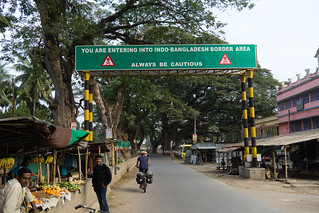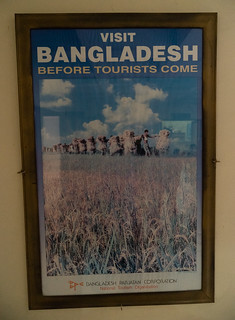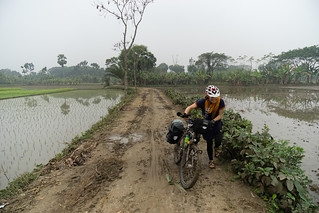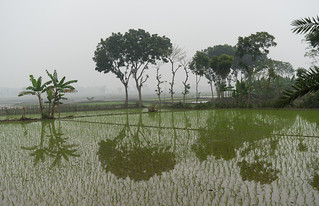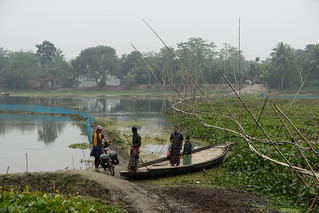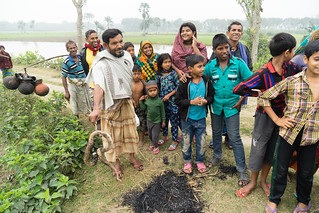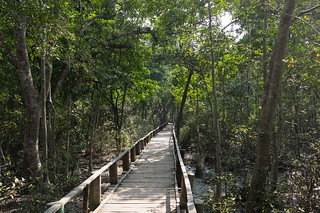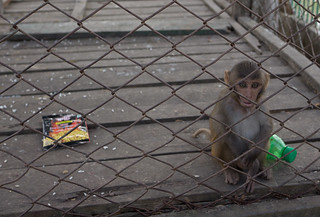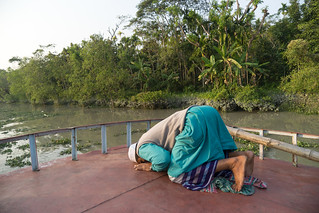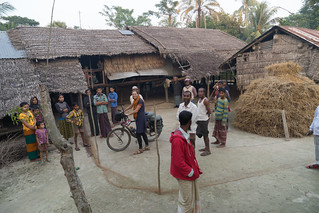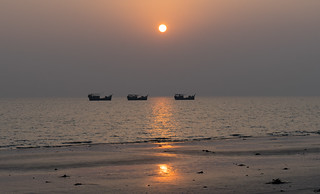The Ganges Brahmaputra Delta — the “Mouth of the Ganges” — is the world’s largest delta. It has been built over the eons by sediment from the Himalaya, and it hosts the world’s largest mangrove forest, the Sundarbans. It is also home to Bangladesh, a country the size of Iowa with about half as many people as the entire population of the United States.
When we planned our journey, the Delta was our goal, and it was where we’d end our ride across Asia. Since then, we’ve extended our journey, and we will instead finish about a month and a half later in Myanmar. Nonetheless, reaching the Delta still felt significant. For months since leaving Turkey, we had told people we were going to Bangladesh, and now we were there. From a climate change perspective it is also an important destination. Few people in the world are more at risk to rising sea levels and stronger storms than the roughly one hundred and fifty million people living in this mega-delta.
We left Kolkata early in the morning after being interviewed for a local TV station. The reporter and cameraman met us at our hotel at 6:30 am and then followed us for a few blocks as we cycled away from the city’s tourist ghetto. Intermittent rain made the city feel both less and more disgusting—the stray dogs (more than I’ve seen in any city, anywhere), rickshaws, and trash on the sidewalks got somewhat washed, but road grime covered our bikes and panniers. We passed a market where wet live chickens were sold in bulk out of baskets to men who would carry a dozen away attached creatively to a bike rack. We saw many people transporting items by rickshaw that should probably be carried by truck—wood, sand, people. We biked on some of the roads in Kolkata that are illegal for bicycles, as the city has outlawed cycling on many of its major roads. (In our TV interview, I did something I never do in such media interviews—I criticized the city of the people interviewing us. I said that Kolkata should be ashamed that it is making it more difficult for bicycles). We enjoyed seeing what Kolkata is like and we enjoyed making new friends there, but we will not miss biking in the city.
Outside of the city, the 80 kilometers to the border with Bangladesh were relatively uneventful. Once we left the urban area, the intensity of traffic decreased a bit, and the road was pleasantly lined with trees that mostly shaded us. But although the surroundings felt more rural, traffic still crowded the road—buses with extra-loud horns, motorbikes, and rickshaws. It didn’t feel as dangerous as some of the other highways we had biked in West Bengal, as the traffic was traveling more slowly, but we could never relax.
We ate a late lunch near the border, where a “reporter” met us and paid for our lunch. We thought he wanted to interview us, but he asked us no questions, partially because he didn’t speak much English. His photographer, who drove the motorbike both of them rode on, snapped pictures of us every two minutes—they clearly planned to write an article about us, even though the language barrier prevented him from actually asking us questions. We assumed he would make up the stories, much like the reporter in Bihar did.
The team followed us to the border, riding just a bit ahead of us on their motorbike. India has built a long fence in an effort to keep immigrants from Bangladesh out of the country. Bangladesh is incredibly poor and densely populated, and tens of millions of people in the country live with a meter of the sea level. As the sea level rises, it’s hard not to wonder where these people are going to go.
Our reporter friend shepherded us through India’s border control. He walked into the office and told the border patrol agents about us, saying something in Bangla about us working on climate change (I only know because to me it sounded like he said “blah blah blah climate blah blah”) and the mustached patrol agents then waved us through with minimal inspection. The reporter was able to communicate to us that he is also a truck driver, which explained his familiarity with the border guards. We got our exit stamp, and in the no-man’s land between the India and Bangladesh the reporter gave us flowers, shook our hands, and then had the camera man capture the moment from several different angles.
We passed a duty free shop, where we bought two warm cans of Heineken (assuming that we’d be unable to find alcohol in Muslim Bangladesh), and then rolled our bikes into the Bangladeshi customs office. Bangladesh now offers visa on arrival for U.S. citizens (as well as for citizens of much of the developed world), and all we had to do was pay the $50 per person visa fee. We were supposed to somehow pay at the bank, he told us, but the bank was now closed. They would “figure something out,” he said, but we would have to wait a bit. We gave them a crisp Benjamin, waited around for about 20 minutes (in which time our first border agent drew us a map of Bangladesh, told us about the good places to visit, and taught us how to say hello, good morning, and thank you in Bengla), and then we were free to enter the country.
We followed the main road for about a kilometer until it entered Benapole, where our first administrative tasks were amazingly easy: the ATM worked, and I was able to buy a sim card and one gigabyte of data with less hassle than anywhere else we’d been. It gives you confidence in a country when such tasks are easy. People—almost all men, as usual—crowded around us, much like in India. But it felt different. The men had beards and many wore the skullcaps we’ve seen in many Muslim countries. Also, unlike in India, they greeted us and smiled instead of staring blankly. What a difference that makes! So many crowds in India had formed without talking to us or showing facial expressions. Now they actually seemed to be welcoming us, even if it was shyly and there were far too many of them. We also felt safer than we had just across the border, but that is partially because we were told Bangladesh had less crime than the parts of India we had recently cycled through.
We went straight to the hotel recommended by the Lonely Planet, and didn’t explore the town. Through India and now Bangladesh we had stayed in hotels almost every night. Hotel rooms are the only places in these population dense countries where we have “our space” and no one can stare at us.
The $15 room had two beds and windows that closed just well enough to mostly keep out the mosquitoes. A poster in the hotel lobby told us to “Visit Bangladesh before the Tourists Come.” I wondered how long it took the Bangladeshi Tourism Board to come up with this slogan. It’s like an empty restaurant telling you to come and eat before all their tables fill up.
Since then, I’ve been trying to come up with alternative slogans. Maybe: “Feel Like A Celebrity: Visit Bangladesh” or “Never Be Lonely: Cycle Bangladesh.”
The next day, we charted our course toward Khulna, the capital of one of Bangladesh’s seven districts, where we had a contact with the head of a local NGO that works with communities in the Sundarbans. As usual, we looked at the walking directions on Google Maps and choose the route that looked the most squiggly.
We turned off the main highway and started riding the narrower winding lines we saw on Google Maps. Bike touring with a smartphone feels like a luxury—there’s no way we’d be able to ask directions along this web of back roads. But a pulsing blue dot on the screen instantly shows us where we are, and we can even click to see the satellite view to assess (to a limited degree) the quality of the road ahead.
What we found was mostly paved one-lane roads that were raised pathways through semi-flooded fields of rice. We couldn’t stop without a crowd forming, but that seemed to be okay, as again, people smiled and greeted us. In one case, a woman ran away from us and returned with flowers, which we tucked into ourhandlebar bags(a friend of hers also tried to give us a dead snake—we declined). We saw some people plowing fields with a three-wheeled machine that sechurned up mud as it slowly moved down each furrow. Others used oxen. It had rained recently, and in one place we had to push our bikes through mud.
Where Google Maps had said there’d be a ferry, we found a man with a pole on a wooden boat that could carry about a dozen people. We loaded our bikes and were pushed across what appeared to be an oxbow. He asked for 40 cents from us. We gave him the money, and later learned that we had probably overpaid by a factor of ten.
Along this route, we tried to interview a number of people about climate change, showing them a sheet we had printed out with our questions written in Bangla (Are summers warmer or colder than when you were a child? Are winters warmer or colder? Does it rain more or less now than when you were young?) Much like in India, we found that many people couldn’t make much sense of our questions. One person would read the worlds slowly, as if sounding them out. It was as if they were just showing that they could read, and not trying to answer or respond to what was written. According to official statistics, less than sixty percent of adults are “literate” in Bangladesh, and I would guess that the number is lower in the countryside. In China and parts of central Asia and Turkey the literacy rate was much higher, and we could see it in people’s eyes when we handed them our questions. They know how to read and respond to them. In Bangladesh there was more confusion. It was sad to see.
We stopped in a small town for lunch at a restaurant that sold rice and dal. As we ordered, a crowd formed and pushed into the place. The crowd of twenty acted like a two thousand watt heater, warming the already hot restaurant. After we ate the meal, we wanted to sit and relax, but the owner told us we had to leave; the crowd was hurting his business.
We spent our second evening in Bangladesh in Khulna, where Mowdudur, the founder of the Centre for Coastal Environmental Conservation (CCEC), an environmental NGO that works with communities near the Sundarbans mangrove forest, treated us to a feast at his home and also let us interview him about his work.
The Sundarbans are the world’s largest mangrove forest, a huge stretch of uninhabited tidally-flooded forest in what is otherwise one of the world’s most population dense nations. The large tides in the Bay of Bengal (about 10 feet!), combined with the huge amount of sediment deposited from rivers, have resulted in a large expanse of land that is just barely above sea level, and which is flooded daily by the tides.
Mowdudur told us that CCED helps find “alternative livelihoods” for people in these communities (basically helping them find work), and that they promote environmental education, helping people learn how to live in better harmony with the forest. Environmental harmony can be a tricky goal, as the mangroves are home to about 400 Bengal tigers, which actually kill a number of people each year.
Early the next morning, we cycled 40 kilometers to Mongla, the location of one of Bangladesh’s two ports and the entry point for the Sundarbans forest. Hiroke, a 25-year-old employee of Mowdudur’s organization, took the bus and joined us in Mongla along with another employee of CCEC (who spoke little English, and whose name we didn’t get). The four of us boarded a boat, and then we motored across the wide river to the Sundarbans visitors’ center.
The visitors’ center included a large map of the mangrove forest, a skeleton of a tiger, a fenced-off pen with about two dozen spotted deer (the most common ungulate of the Sundarbans), a family of monkeys in a cage, and a pond with crocodiles. A raised wooden pathway led from the center through the muddy, partially flooded forest. In the forest we watched water flow through a small canal in the mud, responding to the twice-daily tidal shift in water levels. We then climbed up a tower to gaze across a small part of the forest. On the return to the visitor’s center, some monkeys eyed us from the trees, and one of our guides threw some paper into the forest to lure the monkeys closer, as they were clearly used to tourists feeding them (it’s upsetting to see people who work in the environmental sector throw trash into the natural environment, at a wild animal—although littering is something we’ve seen so regularly on this trip, it also isn’t too surprising). We saw a number of Bangladeshi tourists, but no foreigners. In fact, a few of the Bangladeshis took pictures of us as if we were another type of exotic animal.
We then crossed the river and met with people living in one of the communities right along the edge of the Sundarbans. With the help of Hiroke, we interviewed three of the community members, asking them whether the winters or summers had changed over their lifetimes, whether storms were worse, and whether the monsoons had changed.
The consistent message we got is that life is hard. The biggest problem, everyone seemed to say, is access to basic freshwater. In the dry season, water is saltier in the river than it was when they were younger. The result is that it is hard to find fresh water for many months of the year. They walk a few kilometers just to get water.
The increased saltiness of the river might be because sea levels have risen slightly, thus pushing salt water further inland. Or it could be because India constructed the Farakka Barrage, which siphons off water from the Ganges in the dry season, allowing less to reach Bangladesh. Or it could be because there is less flow in the river in the dry season due to changes in rainfall, or the development of shrimp farms along the coast.
The people we spoke to agreed that the water levels had been rising. They also said that monsoons are coming later and are less predictable than they once were. While we only interviewed a few people, these comments about the monsoons are fairly consistent with what people in Bihar said and with what experts have told us.
We asked one woman what she thought the future of her village would be. If they couldn’t get water, would people go elsewhere? She said they wouldn’t be able to go anywhere else. “We’re poor,” she said, and there were no resources to move. She also told us about how her children had suffered through cholera and various other ailments. Cholera, we thought. It sounded like something out of the middle ages, and it’s sad to hear of such basic ailments destroying somebody’s family.
We also later learned that one of the women we met was a “tiger widow”—her husband had been killed by one of the large cats. My view on conservation was a bit shaken. The world used to be full of predators that competed with—and sometimes even preyed upon—humans, and humanity has slowly wiped them out over the millennia. North America used to have saber-toothed cats and a bear that stood 12 feet tall. Both were wiped out (almost certainly) by Native Americans. These extinctions are sad, but they also make the forests of the world safe for outdoors people like myself. It’s easy to argue for conservation when the animals aren’t trying to kill us.
We motored on the boat back to Mongla, and before saying goodbye to Hikoke we recorded him, using the voice recorder on my iPhone, asking our basic questions about climate change. We would then use these recordings to interview people in the next few days.
The next night, we followed a small road along the edge of the Sundarbans, where human settlements butt up against the protected mangrove forest. Hiroke had told us that people could build embankments, drain parts of the forest, and then, after a few years, actually farm rice on the soil. Riding along the forest, it was clear that this is what people had done to the land that was currently settled. They had carved out land to farm by building small embankments.
A narrow tidal river, about 20 meters across, separated the settlements from the forest, and we stopped at one place where about a dozen people were crowded around a dock, selling fish. We used Hiroke’s recording to interview one man about climate change (we have no idea what he said—we need someone to translate the video), and then we accepted his offer to take a small wooden boat across the river to visit the forest (he spoke just enough English to invite us). Across the river was a small government building—maybe for hosting tourists, but we never really figured it out. And then we walked around the back, where they had a small pond for aquaculture, and where the forest began. We stood there for a bit, listening to the chirps and buzzes of the creatures in the mangroves. “It isn’t safe here,” said our new friend, speaking English. He told us that tigers had killed about 150 people in the communities in that area (or “at least 150 people”). We didn’t linger.
We biked to a mile-and-a-half wide channel, where we found a ferry ready to take us across the river. Google Maps hadn’t shown a ferry, but we’d assumed that such boats would be everywhere there was a river and settlements on either side, and we were right. In fact, the vessel even took us across the river and then 10 km up a canal to the town we had planned to visit, thus cutting off cycling we thought we would need to do. We enjoyed the ride. A woman veiled head to toe tried to talk to Lindsey, but it was tough because she didn’t speak any English (and us no Bangla) and because Lindsey couldn’t see her face, making communication through gesturing and expressions more difficult. At 5pm, a man went to the back of the boat and prostrated himself toward Mecca.
That evening we tried something we haven’t yet done in South Asia: We rolled into a village and asked people where to camp. We played a recording, again from Hiroke, asking in Bangla if we could set our tent somewhere. A crowd gathered. They seemed to suggest we camp by the mosque, a basic one story building with loudspeakers for the call to prayer and a nice grass lawn. I called Mowdudur, our friend in Khulna, and he helped translate over the phone. Mowdudur told us we should go back to the nearest town and find a hotel. We said we didn’t want to—we wanted to camp in the village. We handed the phone to a man who then talked to Mowdudur. When the phone was handed back to me, Mowdudur told us it would be okay to camp by the mosque.
We started setting up our tent, and the crowd (of almost all men) didn’t disperse. They just kept standing there and watching.
While Lindsey went off to find a bathroom (led by some women, who had somehow materialized on the periphery of the sea of men), I set up the stove and cooked a pasta dinner. The crowd hovered and watched, almost closing in. I sat on the ground and closed my eyes for a second. The people of Bangladesh surrounded me, watching me. It was a strange meditative moment, a way to appreciate the sea of humanity that is Bangladesh. I opened my eyes and continued cooking.
Every now and then someone would take a picture of us with his phone. One young man who spoke English asked me “What is your qualification?”—a strange way of asking what I studied. His “qualification” was English—he was getting a master’s in English (although it seemed like he was far from being a master).
Lindsey returned and told me that we could stay with a woman who offered us her place and had indicated that there was gate that could be locked to keep out the crowd. I agreed we should probably go there, as the crowd did not seem like it would disperse. We first ate our dinner, as the crowd quietly watched us slurp the instant noodles.
We packed up our tent in the dark and rolled our bikes across the road to the gate of the woman’s home. Her husband was in Saudi Arabia, working. It seems like every family in the rural areas of every country we’ve visited has a family member working abroad. This family had a two-room house, each room probably two-thirds the size of Lindsey’s and my old bedroom back in the states. They also had an outhouse and a yard with a badminton net and two lights that they turned on so that we could hit the shuttlecock back and forth. The woman had said that she would lock the gate, and it was closed, but they kept on letting people in—most likely family and friends—and soon about eight people were watching us play badminton, and another dozen or so were in the house.
Lindsey was not feeling very well, and was hoping that the people would leave and let us rest. It was amazing how many people fit in the house. I worried the floor would collapse under the weight. And it became warm with so many bodies packed in.
Then a man came in who spoke more English. He said something about how he was the commissioner—or something like that—of the town, and somehow an important government official. He told us we had to go the station, and that it wasn’t safe where we were. We should not stay in the house. Right away, we didn’t like him. He seemed like someone who had an inflated sense of himself, who looked down on the family we were staying with. Our intuition trusted him less than the woman who was hosting us.
After a lot of back and forth—in which I told him we couldn’t leave because my wife was sick—he arranged for us to stay in a larger home just across the street where we had our own private room. We don’t know why the headman wanted us to go to another house. We guessed it was because he somehow didn’t approve of the woman hosting us—maybe because her husband was out of the country or something. Or because some men at the house were chewing betel nut and their mouths were red from the mild stimulant.
The house we stayed in had four rooms and a concrete squat toilet inside the home instead of outside. We are always amazed by how few things people have in their homes. We often feel like we have more individual items on our bikes than most people own (and we are definitely carrying around greater retail value). We got our own room (someone must have gotten kicked out of their bed), which we could lock. It was hard to be grateful to our new hosts (a family obviously approved of by the headman) when we had been forced to go there, and leave a woman who Lindsey had befriended and liked. However, the new family was friendly and generous, and served us breakfast the following morning. Our friend from the night before also came over, so we got to see her again.
The next day was a series of ferries and short rides as we charted a course toward the Bay of Bengal. A man on a motorcycle befriended us in the late morning, as much as someone with very limited English can, and drove next to us for about a third of the day, including stopping with tea and helping give us directions for finding a boat to Dhaka, which we ended up doing two days later.
Toward the end of the day, about 15 kilometers away from the beach town of Kuakata, we found one of the narrow paved roads, suitable only for bicycles and motorbikes, that we had come to love. This one was one of our favorites. The population density seemed a bit lower here, perhaps because it was so close to the ocean and the fields were less productive due to saltwater or the increased difficulty in getting freshwater to irrigate.
About forty-five minutes before sunset we started playing people the recording of Hiroke’s voice asking if we could camp. The first people waved us on. The second group stopped and thought about it and told us to wait. I realized that the people there looked different—they appeared Southeast Asian, not South Asian. One girl, who looked to be in her late teens, had mud painted on her cheeks.
The houses also looked different. They were all wooden structures on stilts. One of the people in the group pointed up to one of the houses, basically saying we could stay there. Then we were led by a man who was probably in his fifties around a few of the homes (they were tightly clustered, with trees around them, with fields beyond the trees). He spoke some English and told us we could stay in a room there.
We wheeled our bikes around and brought our bags in. The room had a small shrine to Buddha, and a Buddha calendar.
Soon, a pudgy man in his sixties who spoke good English showed up. He told us they were Rakhine people, from Myanmar. Their people had fled Myanmar about 200 years earlier, and had lived in this part of Bangladesh ever since.
He had become an engineer and then went to Iraq in the late 70s to work. At some point he seemed to say he was making weapons, which he seemed not to like—or maybe he was tricked into engineering weapons. He had gone to a missionary school, which is why he spoke English. However, he wasn’t much of a listener, and preferred to talk at us rather than answer our questions, and he had a habit of finishing our sentences with things we weren’t planning to say.
He complained that his people, the Rakhine, were losing land at the hands of the other communities. He also told us about a machine he built that would produce more energy than was put into it using a system of gears and mechanical advantage. I didn’t have the heart to tell him that his perpetual motion machine was impossible, as it violates basic rules of physics. He left us to go home and get the blueprints for this machine, temporarily leaving us alone.
While he was gone, we were alone in the room while the woman of the house did her prayer before the Buddha. At the same time, we heard crickets chirping outside, and in the nearby Muslim village a loudspeaker was conveying the call to prayer.
It was in this moment that “the magic” of the trip came back. Sitting in the Rakhine house on stilts, we were jolted into realizing where we were: in a remote corner of Bangladesh, hosted by people we had met that day, with people praying to different gods all around us. The mix of crickets, Muslim prayer, and Buddhist chants felt like a declaration about the beauty, diversity, and generosity of the world. Moments like this are a major reason why we rode our bikes across Asia.
Our friend returned with blueprints and a series of letters from various potential funders rejecting his requests for money. The blueprints were professionally drawn, clearly demonstrating that he had training in design. But it was still a drawing for a perpetual motion machine. I’ll believe in the Buddha before I believe in that.
Our hosts served us a dinner—an assortment of meats, some rice, and what we thought were eggs but which had a peculiar membrane connecting them, making us suspect that they were in fact organs of an unknown animal. We didn’t eat those. Our hosts, though, didn’t speak to us. They just gave us food and walked back into the kitchen, leaving us to hang out on our own.
We slept well that night, listening to the crickets.
In the morning, our hostess gave us a blanket that she had woven herself. She said it took her three days to make.
We followed a long route to the beach. I regretted this when Lindsey was feeling sick and we were pushing our bikes through the sand. But we also saw rows of boats and fish drying, recently caught, and we rode along the embankment that protected the farmland from the ocean. I found the embankment relatively unimpressive. I think it was supposed to be 5 meters (16 feet) tall, but it seemed shorter to me. I would definitely want more between me and the next cyclone.
We made it to town around 2pm, at which point we found the nicest hotel in town ($15 for the night) and took a nap. We then walked to the beach.
Kaukata is a tourist town for Bangladeshi tourists, not foreigners. It had the relaxed feeling of a beach town. But the shops were targeted at Bangladeshis. The little open-air booths sold knick-knacks such as shells and cheap necklaces. We saw only four other foreigners in the town.
The beach chairs were mostly empty. It was December and the temperature was in the high sixties, which is downright freezing if you’re a Bangladeshi. We strolled down the wide beach, walking by the rows of empty beach chairs. Although the beach wasn’t crowded, every now and then a group of Bangladeshis would approach us and request—no, demand—a picture with the foreigners.
It felt nice to sit on the beach, even if we could only do so for 20 minutes before being approached, and even if it wasn’t quite warm enough to enjoy the water. The Bay of Bengal was mostly calm, and the beach curved in such a way that we could watch both the sunrise and the sunset over the water. We chose to see only the sunset—we’ve seen enough sunrises on this journey.
We left town at about 11am the next morning and biked the 45 kilometers to a dock where a three-story boat, which we planned to take to Dhaka, waited for us. We rolled our bike along a wooden ramp to the boat, where we were led to a small cabin. For $10 each, we got a 24-hour boat ride and our own cabin. Our journey through the heart of the Ganges Delta had come to an end. We had achieved our trip’s goal of reaching the mouth of the Ganges.
Unlike the parts of India we had just recently traveled, I would recommend Bangladesh to other cycle tourists. When I now look at the impressive satellite image of the waterways snaking through the green islands of the mouth of the Ganges, I think not only of the country’s vulnerability to climate change; I think of how you can roll your bike up to almost any of these rivers and find a boat ready to take you across it. And I think of the one-lane roads raised above the flooded rice fields, the crowd of friendly men who surrounded our tent, and the cricket-Buddhist-Muslim music we enjoyed just a few miles from the Bay of Bengal.








